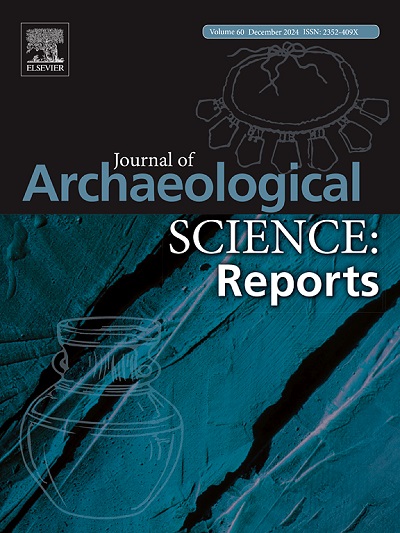通过稳定同位素分析研究战国晚期(约公元前 221 年)中国鄂尔多斯高原东部的生存经济
IF 1.5
2区 历史学
0 ARCHAEOLOGY
引用次数: 0
摘要
本案例研究展示了 40 块人类骨骼的稳定碳和氮同位素结果(δ13C 值范围:-9.7 ‰ ∼ -7.7‰,平均值 ± SD 值:-9.7 ‰ ∼ -7.7‰):-9.7‰∼-7.7‰,平均值± SD值:-8.6±0.4‰;δ15N 值范围:中国战国晚期(约公元前221年)鄂尔多斯高原东部川藏墓地出土的δ15N值范围:6.7‰∼10.0‰,平均值±标准差:8.3±0.7‰)表明,过去的人群主要以C4食物为主。尽管考古学文化不同,但川张墓地中的所有过去人群都有相似的饮食模式和生存经济。根据考古和历史分析,川张墓地的人们主要以小米为主的农业为生,畜牧业为辅。对比相邻墓地和同时代墓地公布的同位素数据,我们可以得出结论:以粟为主的农业是内蒙古中南部地区一贯的、占主导地位的生存经济,这也为战国晚期中原政府控制鄂尔多斯高原东部提供了坚实的物质基础。本文章由计算机程序翻译,如有差异,请以英文原文为准。
Subsistence economy in the eastern Ordos Plateau, China during the late Warring States Period (c. 221 BCE) by stable isotope analysis
This case study presents stable carbon and nitrogen isotopic results of 40 human bones (δ13C value range: −9.7 ‰ ∼ −7.7 ‰, mean ± SD value: −8.6 ± 0.4 ‰; δ15N value range: 6.7 ‰ ∼ 10.0 ‰, mean ± SD value: 8.3 ± 0.7 ‰) from the Chuanzhang cemetery in the eastern Ordos Plateau, China during the late Warring States Period (c. 221 BCE), which indicate that the past populations mainly relied on C4-based food. Despite different archaeological cultures, all past populations in the Chuanzhang cemetery had a similar dietary pattern and subsistence economy. Based on archaeological and historical analysis, people in the Chuanzhang cemetery made their living mainly by millet-based agriculture, supplemented by animal husbandry. Comparing isotopic data published from adjacent and contemporary cemeteries, we can conclude that millet-based agriculture was a consistency and dominated subsistence economy in central-south, Inner Mongolia, which also provided a solid material foundation for the central plains government to control the eastern Ordos Plateau during the late Warring States Period.
求助全文
通过发布文献求助,成功后即可免费获取论文全文。
去求助
来源期刊

Journal of Archaeological Science-Reports
ARCHAEOLOGY-
CiteScore
3.10
自引率
12.50%
发文量
405
期刊介绍:
Journal of Archaeological Science: Reports is aimed at archaeologists and scientists engaged with the application of scientific techniques and methodologies to all areas of archaeology. The journal focuses on the results of the application of scientific methods to archaeological problems and debates. It will provide a forum for reviews and scientific debate of issues in scientific archaeology and their impact in the wider subject. Journal of Archaeological Science: Reports will publish papers of excellent archaeological science, with regional or wider interest. This will include case studies, reviews and short papers where an established scientific technique sheds light on archaeological questions and debates.
 求助内容:
求助内容: 应助结果提醒方式:
应助结果提醒方式:


